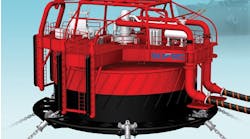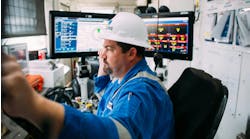InterMoor launches new deepwater installation method
Installing subsea structures from anchor-handling vessels saves time, money
Installation of equipment in deep waters such as permanent mooring systems and marine trees is typically performed from large construction vessels or drilling rigs. InterMoor Inc., an Acteon company, has devised a subsea installation method that enables companies to install different types of equipment from small, easily available vessels such as anchor-handling vessels (AHV). This technique offers a cost-effective and timesaving alternative.
The compensated anchor-handler subsea installation method (CASIM) is a complete package for the installation of trees, manifolds and other subsea structures. It incorporates detailed engineering work, dynamic lowering analysis, operational procedures, tools, equipment and offshore personnel.
The origin of this system was founded during the installation of large suction anchors for Kerr-McGee’s Red Hawk spar in the GoM. The spar is installed in 5,300 ft of water. “The challenge was that once an anchor was launched and over the side, which was a feat in its own right, we had to minimize the loads while lowering the anchor onto the seabed,” says Tom Fulton, vice president, engineering and projects, InterMoor. “With such a large object and the vessel’s movement with the waves, the dynamic loading on the line is significantly increased.”
A key factor in the success of the project was the heave-compensation mechanism that was used; without this, the job could only have been done in very calm conditions. The heave compensator is a single-unit cylinder that acts as a shock absorber. It reduces motion and line tensions by acting as a soft, dampening spring applied in series with the stiffer lowering components. The cylinder is charged with nitrogen gas to a specified gas pretension before launch and is lowered in-line above the object. As part of the CASIM process, the heave compensator is tuned to the object’s load and mass, water depth, sea conditions and the desired acceleration at depth.
After evaluating different heave-compensation methods, InterMoor selected its current technique mainly because of the space-saving design that facilitates the installation of many objects in a single journey. The other alternatives available were bulky and would have meant transporting the anchors one at a time, which increases time and cost requirements.
The necessary pretension for the heave compensator is determined by dynamic lowering analysis. For this analysis, CASIM applies the time-domain marine-simulation program OrcaFlex, which uses information such as the water depth, environmental conditions (e.g., wave energy), the lowering-line properties (e.g., mass and stiffness), the properties of the object being lowered and the vessel’s characteristics. This information is used to model the various components in 3D under varying conditions, to predict the motion of the object being lowered and the tension in the line.
Through experience and knowledge gained from this experience, InterMoor has developed the system for application with other equipment such as trees and manifolds. Large objects like suction piles require analysis through the entire water column, as resonance could lead to AHV winch or line overload. Lighter objects such as trees and manifolds only require analysis at the seabed, as the concern is with motion rather than load.
“For the anchor, we were most concerned with the tension in the line; we did not want the line to break or the winches on the vessel to be overloaded,” says Fulton. “With the heave-compensation device, you have two important advantages. First, if you reduce the motion of the object, you reduce the dynamic tension. The device is also beneficial in that it facilitates a soft landing for the object on the seabead. This is particularly important for items such as trees or manifolds.”
“With CASIM, you do not need to use special vessels; you can use easily available AHVs and compact equipment that will fit onto them. You do not need extra winches either; the vessels already have winches. However, you do need to incorporate heave-compensation, and for this you need to perform detailed engineering work,” explains Fulton.
InterMoor has proven that this type of subsea installation method can be performed from an AHV, but it has to be planned and engineered correctly. CASIM is offered as a complete package, with planning, procedures, equipment and personnel. “Using this method, rather than working from a large construction barge or drilling rig, has proven to significantly reduce the time and cost of installation,” concludes Fulton.•




